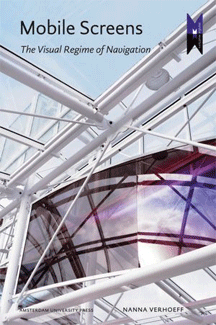By Svetlana Alpers
Reading this book made me a bit uncomfortable as, I must admit, the world it addresses also can do. From the cover image and the title, I took this to be an odd book about shipping. But no, navigation refers to the way people interact with screens. The book defines and defends the world of screens—movies, TV, computers, Ipods, Nintendo games, public displays on buildings, in airports. The regime of the subtitle is a rhetorical usage that has little resonance here. But it fits the tone of a book which is unashamedly academic even though its topic is of broad interest.
It is curious that in a visual age awash with screens no one anymore seems to take time to stop and look. Everyone is moving about, along with the images. Indeed, that is a basic argument of this book. While I want a map to be a still image I can look at like a picture, people today want to finger a map and move it about. Written from the point of view of the touchscreen and the emphasis on tactility, Nanna Verhoeff remarks, “The eye had it coming; it needed to be dislodged as the queen of the senses.” On her account, the observer is no longer in a fixed position looking out at the world or even at an image of it. Rather, the observer interacts with screens by using remotes, or touching with the hands to change the image. The mobility of the visual experience and its screen-based access are basic.
A well-known specialist in media studies has argued that we are still not free of the age-old screen culture—a flat rectangular surface, like a painting, existing in the space of our body and acting as a window into another space. By contrast, Verhoeff’s book treats the media screens of today as new. Her chapters consider in turn: 1) the windshield of a moving car; 2) the self-reflexive nature of screens; 3) consoles; 4) screens in urban and public spaces; 5) interactive cartography. Travel is the commanding model of visual experience. Verhoeff (herself a student of those early movies featuring onrushing trains) describes the multiple screens in the world as a virtual travel machine.
Of course, artists in the past had assumed mobile viewers. I think of Tiepolo’s huge Treppenhaus at Würzburg. But even when treating looking as a process, the artist assumed that work of art was still and at a distance. Looking depends on distance. It is has been said that losing that we lose something (something aesthetic, let us say) about the look of a thing─be it a painting, or be it the world. But doesn’t immersion in the performative visuality of a screen mean that we are losing something of ourselves? Losing what it is to be an individual self looking out?
Svetlana Alpers, an artist, critic and renowned art historian, is professor emerita of the history of art at the University of California, Berkeley and a visiting scholar in the Department of Fine Arts at New York University.




